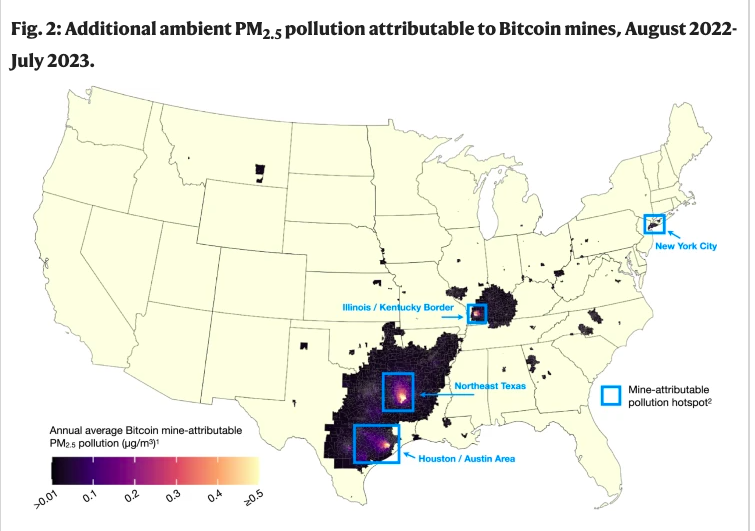Last updated:
 Why Trust Cryptonews
Why Trust Cryptonews

Key Takeaways:
- Fine particle pollution from U.S. Bitcoin mining facilities is traveling across state lines according to a recent study.
- Fossil fuels drive most mining-related emissions.
- Experts are urging federal action to close regulatory gaps.
A newly published peer-reviewed study has raised alarms over the environmental and public health impact of Bitcoin mining in the U.S.
According to the research, emissions from major mining facilities emit dangerous fine particulate matter (PM2.5), which travels far beyond its local environment and harms millions of Americans in distant states.
PM2.5 Pollution from Bitcoin Mining Exposes 1.9 Million Americans
Published in Nature Communications on March 26, the study titled “The environmental burden of the United States’ bitcoin mining boom” was led by Dr. Francesca Dominici of Harvard’s T.H. Chan School of Public Health.
The researchers examined the top 34 Bitcoin data mining facilities in the U.S. between August 2022 and July 2023.
Their findings show that these facilities consumed 32.3 terawatt-hours of electricity, 33% more than the entire city of Los Angeles, with 85% of that energy sourced from fossil fuels.
As a result, this mining activity exposed an estimated 1.9 million Americans to elevated PM2.5 levels.

New York City, the Houston/Austin corridor, northeast Texas, and parts of the Illinois/Kentucky border were identified as zones with the highest exposure.
Residents in these regions were exposed to ≥0.5 μg/m³ of additional PM2.5 directly attributable to Bitcoin mining, a concentration linked to increased health risks and premature deaths.
A key concern is the cross-border nature of the pollution.
The study cites examples like residents in Metropolis, Illinois, who are exposed to PM2.5 emissions from a power plant in Kentucky that supports a Bitcoin mine in North Carolina.
Such cases expose a regulatory blind spot, as state governments lack jurisdiction to control pollution caused by out-of-state activities.
The study suggests the U.S. Environmental Protection Agency (EPA) could address this with a “Good Neighbor” rule that mandates upwind states to curb power plant emissions more aggressively.
Growing Scrutiny of Bitcoin Mining Environmental Toll
This isn’t the first time Bitcoin mining has drawn criticism for its environmental footprint.
In March 2024, a Pennsylvania-based NGO, Save Carbon County, sued Stronghold Digital Mining for allegedly burning waste coal and tires to generate electricity.
The lawsuit, filed in a state court, is the first of its kind to invoke Pennsylvania’s constitutional right to a clean environment as a basis to challenge the state’s approval of crypto mining permits.
At a global level, the International Monetary Fund (IMF) has also flagged crypto mining as a rising energy threat.
In an August 2024 report, the IMF estimated that cryptocurrency mining and data centers now consume 2% of total global electricity.
In response, the IMF has proposed a bold measure–an 85% increase in electricity taxes on crypto miners.
Such a levy could generate $5.2 billion annually and slash carbon emissions by 100 million tons, comparable to Belgium’s yearly emissions.
Mixed Industry Response and Sustainable Innovation
Not everyone agrees with the gloomy outlook for Bitcoin mining, however.
Mason Jappa, CEO of U.S.-based mining firm Blockware Solutions, criticized a recent study’s assumptions, claiming it relied on outdated mining hardware efficiency figures, which may overstate energy consumption.
At the same time, sustainable innovation within the mining sector is beginning to emerge.
In Finland, infrastructure the firm Hashlabs Mining launched a pilot project using hydro-cooled WhatsMiner M63S ASIC rigs to produce hot water as a byproduct of Bitcoin mining.
This heat is then redirected through district heating networks to warm households, a rare case where crypto mining energy is repurposed for community benefit.




















